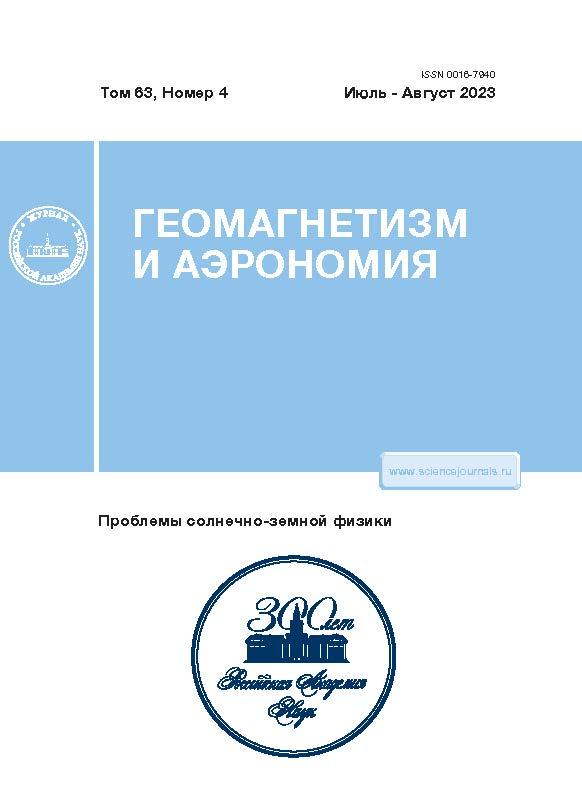Features of Forecasting the Operation of Ionospheric Radio Lines in Upper Rays Modes
- Autores: Krasheninnikov I.V.1, Shubin V.N.1
-
Afiliações:
- Pushkov Institute of Terrestrial Magnetism, the Ionosphere, and Radio Wave Propagation, Russian Academy of Sciences (IZMIRAN)
- Edição: Volume 63, Nº 4 (2023)
- Páginas: 473-480
- Seção: Articles
- URL: https://ruspoj.com/0016-7940/article/view/651000
- DOI: https://doi.org/10.31857/S0016794023600096
- EDN: https://elibrary.ru/ONBNOB
- ID: 651000
Citar
Texto integral
Resumo
The frequency dependence of transmitted information qualitative indicators is analyzed on the
example of two meridional radio links: single-hop (~2600 km) and dominant two-hop (~5100 km) for basic
modes of radio wave propagation in the ionosphere. It is shown that the presence of highly efficient receivingtransmitting
antennas in a radio communication system leads to the need to take the existence of a priori energetically
extremely weak modes into account in the problem of radio path specification statement. In this
case, we consider those formed exclusively by the mechanism of radiation transfer along the upper-angles ray
trajectories in the ionospheric propagation of radio waves. If the angles of departure and arrival for such
modes and the directions of the main lobes of the antenna patterns at the end points of the radio path coincide,
the signal-to-noise ratio for the wave field can reach the required threshold value and ensure the successful
operation of the radio communication system. This may expand the upper frequency limit for the passage
of radio waves in the transition regions of jump propagation of radio waves in the ionosphere; it should
be taken into account in forecasting the operation of ionospheric radio links.
Sobre autores
I. Krasheninnikov
Pushkov Institute of Terrestrial Magnetism, the Ionosphere, and Radio Wave Propagation, Russian Academy of Sciences(IZMIRAN)
Email: krash@izmiran.ru
Troitsk, Moscow oblast, 142190 Russia
V. Shubin
Pushkov Institute of Terrestrial Magnetism, the Ionosphere, and Radio Wave Propagation, Russian Academy of Sciences(IZMIRAN)
Autor responsável pela correspondência
Email: shubin@izmiran.ru
Troitsk, Moscow oblast, 142190 Russia
Bibliografia
- – Айзенберг Г.З. Коротковолновые антенны. М.: Радио и связь, 815 с. 1962.
- – Деминов М.Г., Шубин В.Н., Бадин В.И. Модель критической частоты Е-слоя для авроральной области // Геомагнетизм и аэрономия. Т. 61. № 5. С. 610–617. 2021. https://doi.org/10.31857/S0016794021050059
- – Дэвис К. Радиоволны в ионосфере. М.: Мир, 502 с. 1973.
- – Кравцов Ю.А., Орлов Ю.И. Геометрическая оптика неоднородных сред, М.: Наука, 304 с., 1980.
- – Крашенинников И.В., Павлова Н.М., Ситнов Ю.С. Модель IRI в задаче прогнозирования ионосферного прохождения радиоволн в условиях высокой солнечной активности // Геомагнетизм и аэрономия. Т. 57. № 6. С. 774–782. 2017.
- – Крашенинников И.В., Шубин В.Н. Частотная зависимость энергетических параметров волнового поля на предельной дальности односкачкового распространения радиоволн в условиях низкой солнечной активности // Геомагнетизм и аэрономия. Т. 60. № 2. С. 220–228. 2020.
- – Маковий В.А., Чупеев С.А. Cигналы с перестановочной модуляцией и их свойства // Теория и техника радиосвязи, изд. ОАО “Концерн "Созвездие”. № 1. 13–24. 2010.
- – Руководство URSI по интерпретации и обработке ионограмм. Перевод с англ. второго издания “URSI Handbook of Ionogram Interpretation and Reduction”. Ред. Н.В. Медникова. М.: Наука. 342 с. 1978.
- – Шубин В.Н., Деминов М.Г. Глобальная динамическая модель критической частоты F2-слоя ионосферы // Геомагнетизм и аэрономия. Т. 59. № 4. С. 461–473. 2019.
- – Bilitza D., Altadill D., Truhlik V., Shubin V., Galkin I., Reinisch B., Huang X. International Reference Ionosphere 2016: from ionospheric climate to real-time weather predictions // Space Weather. V. 15. P. 418–429. 2017. https://doi.org/10.1002/2016SW001593
- – Maslin N.M. HF Communication: A System Approach. Pitman Publishing. 240 p. 1987.
- – Verhulst T., Altadill D., Mielich J. et al. Vertical and oblique HF sounding with a network of synchronized ionosondes // Adv. Space Res. V. 60. I. 8. P. 1644–1656. 2017. https://doi.org/10.1016/j.asr.2017.06.033
Arquivos suplementares















